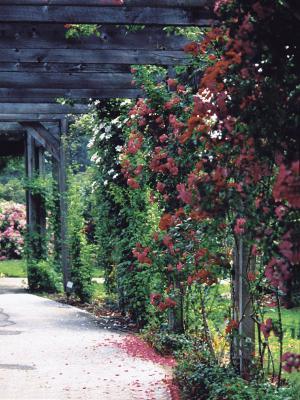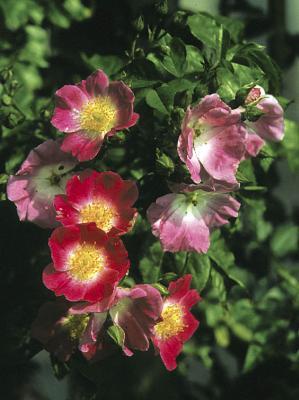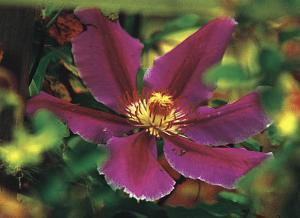The romantic pergola garden
 |
|
| A romantic pergola walkway at the Royal Botanical Garden in Hamilton, Ont. |
My dictionary defines a pergola as an arbour or covered walk, formed of growing plants trained over trelliswork. Its root comes from the Latin, French and Italian pergula, a projecting roof and French pergere, to proceed. A pergola should, therefore, be an enclosure that invites us to proceed (walk) beneath it. Leave it to the French and Italians to label such a romantic walkway.
In many public formal gardens, a pergola covered with climbing roses and clematis forms an integral part of the design. Often constructed of simple timbers, the structure adds a sense of year-round permanence and stability to the garden.
The Rose Garden at the Royal Botanical Garden (RBG) in Hamilton, Ontario is home to one of my favourite pergola strolls. Like two outstretched arms, the semi-circular pergola (bisected by a teahouse) embraces the formal rose garden.
On a summer's day, the breezy shade of the pergola offers a welcome retreat from the heat. The sun drenched rose gardens can be viewed through the lacy windows created by vines and small trees espaliered along the structure. For those interested in learning more about climbing plants, pruning techniques and ingenious methods of support, the walk provides as much illustrated instruction as a textbook. Built on a smaller scale, there is little to compare with the romance an arbour or pergola covered with roses and clematis can add to a garden.
Climbing roses suitable for such a structure include the classic 'American Pillar,' offering single roses of cerise pink with vibrant white centres on vigorous, healthy plants. 'New Dawn' will reliably climb and cover an arbour with a flush of shell pink, fragrant blooms in June, continuing to flower (though not as profusely) all summer. The deep rose pink 'Zephirine Drouhin' is delightfully scented, thornless, hardy and a repeat bloomer.
Rambling roses such as the buff-pink 'Avalanche' and the pale pink Explorer rose 'John Davis' can both be trained as climbers, as well. Suitable for smaller structures, they are
very disease resistant and hardy. They bloom almost continually.
|
Clematis, woven among the roses, or grown separately will offer their own special charm.
A selection of early, mid and late season bloomers will assure continuous colour over a long period. Marry roses and clematis that will require pruning in the same season for ease of maintenance. (This will prevent the frustrating and frequently painful disentangling of clematis stems from thorny rose canes). Create a memorable garden picture by pairing the clematis 'Jackmanii' (with deep purple blooms) and pale pink 'New Dawn' roses on an arbour or pergola. For a romantic blue garden, under-plant clematis 'Etoile Violette' with a skirt of Salvia nemerosa and Brachyscome 'Purple Splendor'. Clematis are available in delectable shades ranging from pure white through pink and cerise to deepest purple. Equally charming are the images their names inspire, consider 'Comtesse de Bouchard,' 'Ville de Lyon,' and 'Candida,' to name but a few. Of special interest on the RBG pergola are the many espaliered vines and small trees. Typical climbers include hydrangea, wisteria, trumpet vine, Dutchman's pipe, euonymus and hardy kiwi, all grown to perfection. More surprising are the many samples of espaliered trees such as magnolia, serviceberry and crabapple (to name a few) to be found along the walk. These are trained into a fascinating variety of traditional patterns such as the candelabra, single cordon, Belgian fence (looks like basket weave) and the familiar tiered horizontal cordon (the way grapes are grown). Espaliered trees offer a unique way to add interest to a boring stretch of wall or fencing for the patient (and somewhat ambitious) home gardener. They allow the gardener an opportunity to make the most of a small space, while adding old world charm to a young garden. A simple pergola built along the side a home or garage (above that boring stretch of sidewalk no one seems to know how to improve), will support a romantic collection of flowering vines and roses or simple espaliered vines. What better way to welcome visitors to a garden? Theresa M. Forte is a freelance garden writer, photographer and garden consultant based in Niagara Falls, Ont. Images courtesy Theresa M. Forte |

